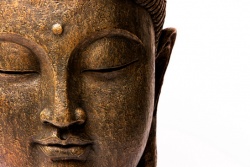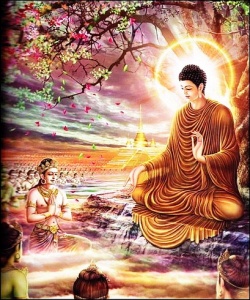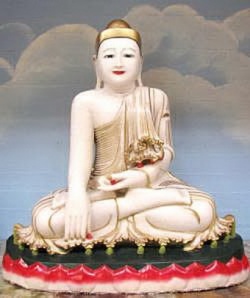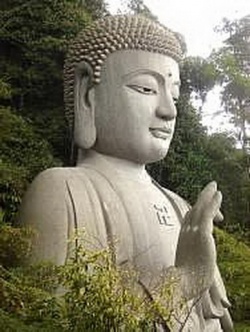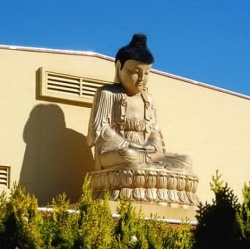The Origins of ‘Skilful Means’ in Early Buddhism
by Peter Nelson
(Peter Nelson holds a Ph.D. (1998) in Madhyamaka philosophy studies from the
University of Queensland in Brisbane, Australia, and is a freelance writer on Buddhism)
The early Buddhist scriptures (Pali suttas) record that at the time of his enlightenment (c. 450 B.C.E.) – when Siddhattha Gotama attained nirvana and therefore freed himself from the wheel of death and rebirth (samsara) – he initially recoiled at the prospect of teaching his experience to other people.1. The Buddha, or ‘Awakened One,’ as he was henceforth known, feared that his teaching (dhamma) was too difficult for a generation that ‘delights in worldliness’ to understand, and that its realization lay beyond their spiritual grasp:
‘Those dyed in lust, wrapped in darkness,
Will never discern this abstruse Dhamma
Which goes against the worldly stream,
Subtle, deep, and difficult to see.’
At this point, however, the god Brahma, who feared the world would ‘be lost’ if the Buddha chose to pass into nirvana without teaching his path, descended from heaven and appeared before him. He then eloquently urged the Buddha, on behalf of all suffering beings, that his teaching was desperately needed and that he should remain in samsara:
‘Just as one who stands on a mountain peak
Can see below the people all around,
So, O Wise One, All-seeing Sage,
Ascend the Palace of the Dhamma.
Let the Sorrowless One survey this human breed,
Engulfed in sorrow, overcome by birth and old age.
Arise, victorious hero, caravan leader,
Debtless one, and wander in the world.
Let the Blessed One [i.e. the Buddha] teach the Dhamma,
There will be those who will understand.’
Moved by Brahma’s passionate plea, the Buddha surveyed the world with his spiritual eye and saw that there were indeed people of different predilections – ‘some with little dust in their eyes and with much dust in their eyes, with keen faculties and with dull faculties … easy to teach and hard to teach.’ His deep compassion (karuna) stirred by this vision, the Buddha resolved to remain in the world and accept Brahma’s request to teach the dhamma to all:
‘Open for them are the doors to the deathless,
Let those with ears now show their faith …’
Setting aside the obvious mythological overtones, all Buddhist traditions accept the historical basis of this story. That is, they believe the Buddha experienced enlighten-ment at Gaya, initially despaired of communicating it, but after some weeks of deliberation resolved to teach his dhamma to the world. However, having taken this decision, the Buddha was faced with the daunting task of rendering the dhamma accessible to everyone – of devising a teaching strategy which could equally accommodate pupils ‘with keen faculties and with dull faculties.’ His solution to this problem was the practice of ‘skilful means’ (upaya-kosalla). Starting from the conviction that nirvana was beyond thought and linguistic expression, the Buddha asserted that his spiritual teaching was only a useful ‘pointer’ to the truth – not the truth itself. This meant that the dhamma – because merely provisional - was neither fixed nor dogmatic. Rather, being an expedient ‘means’ (upaya) to an end, this teaching was – like Socrates’ celebrated dialectical method - dynamic and contextual. This pragmatic philosophical stance gave the Buddha enormous flexibility – it meant he was free to adjust or change his teaching to suit the level of his audience.
In its basic form, ‘skilful means’ appears in the early Buddhist texts as simply a progressive or ‘gradual instruction’ (anupubbi katha) on the dhamma. When teaching to spiritually mature pupils, the Buddha directly explains complex philosophical aspects of his doctrine.3. To beginners, however, he offers preparatory lessons on general spiritual virtues before moving to advanced topics. This process is clearly illustrated in the account of his teaching to Upali:
‘Then the Blessed One gave the householder Upali progressive instruction, that is, talk on giving, talk on virtue, talk on the heavens; he explained the danger, degradation, and defilement in sensual pleasures and the blessing of renunciation. When he knew that the householder Upali’s mind was ready, receptive, free from hindrances, elated, and confident, he expounded to him the teaching special to the Buddhas: suffering, its origin, its cessation, and the path.’ 4.
In its more advanced guise, ‘skilful means’ assumes forms that in other contexts could be construed as contradictory, or even heretical. For example, in the Tevijja sutta, 5. two young brahmins (followers of the Vedic or Hindu tradition) cannot decide which Vedic teacher offers the correct path to ‘union’ with the aforementioned god, Brahma. Having heard of the Buddha’s wisdom, they approach him for advice on the matter. The Buddha, though, does not accept ‘union with Brahma’ as the final goal of salvation - for him salvation is the atheistic ‘extinction’ of nirvana.6. However, recognizing the brahmins’ sincerity and spiritual potential, he retains their religious terminology and through a progressive question-answer session seeks to wean them from their theism. Firstly, he points out that because the Vedic sages have not seen Brahma ‘face to face,’ they cannot guarantee Brahma’s ultimate ontological status. He then points out that, unlike Brahma, these sages are ‘encumbered’ by the five hindrances,7. and therefore lack the moral purity to achieve ‘communion’ with him after death. By contrast, because he is ‘unencumbered’ by the five hindrances, the Buddha claims that he possesses genuine spiritual knowledge. In deference to the spiritual level of the two brahmins, however, he presents this transcendent knowledge using Vedic terminology:
‘…I know Brahma and the world of Brahma, and the way to the world of Brahma, and the path of practice whereby the world of Brahma may be gained.’
The young brahmins, won over by the Buddha’s arguments, now ask him to teach this way to ‘union with Brahma.’ The Buddha, though, changes tack and introduces them to his ‘holy life’ – in particular the purifying meditation on the ‘divine abodes’ (brahma-vihara). Through this exercise, he points out that the practitioner cultivates the moral virtues of loving-kindness, compassion, sympathetic joy and equanimity, and psychically transmits them to the four points of the compass. The Buddha assures them that this is the correct ‘way to union with Brahma’ – a ‘way’ which by now has subtly morphed into a preparatory stage on the path to nirvana. The two brahmins, grateful for this illuminating teaching, praise the Buddha’s ‘gradual instruction’ and its revelatory power:
Excellent, reverend Gotama., excellent! It is as if someone were to set up what had been knocked down, or to point out the way to one who had got lost, or to bring an oil-lamp into a dark place, so that those with eyes could see what was there. Just so the reverend Gotama has expounded the dhamma in various ways.’
Similarly, it is well known that the Buddha emphatically denied any notion of a permanent soul (atta). Instead, he maintained that the human being is comprised of five impermanent ‘aggregates’ (khandha).8. When, though, the Buddha is confronted with a Charvaka (materialist) who believes that the human being is comprised only of the four elements (earth, air, fire and water) and that there is no moral mechanism of karma and rebirth, he recognizes that strong ‘medicine’ 9. is required. To wean the Charvaka from his extreme materialism, the Buddha therapeutically presents him with the opposite extreme - the idealist belief in a permanent soul (atta).10. While, in the Buddha’s view, this Vedic doctrine is also false because a permanent soul contradicts the evidence of experience, he deems it preferable to materialism because it recognizes a moral dimension of reality. That is, if the soul is an enduring entity, then it is a morally responsible agent. According to the Vedic law of karma the everyday actions of the human being determine his or her soul’s destiny. Also, the Buddha judges that at this stage of the Charvaka’s instruction, the ‘permanent soul’ is easier to grasp intellectually than his empirical theory of the ‘aggregates.’ Then, when he is satisfied that the Charvaka is sufficiently cured of his nihilistic beliefs, and that his mind is clear and receptive, the Buddha sets the soul-doctrine aside and advances his own theory 11. of the human personality.12.
The foregoing paradigm of ‘skilful means’ pioneered by the Buddha in the early suttas provided a template for all future developments in Buddhist pedagogy. In later Mahayana Buddhism, in particular, ‘skilful means’ (Sanskrit: upaya-kaushalya) – along with wisdom (prajna) – was the defining quality of the Bodhisattva, the ‘enlightenment being’ who postpones final entry into nirvana until all sentient beings have been guided to enlightenment. ‘Skilful means’ also proved pivotal to Buddhism’s successful expansion from India into other Asian countries, 13.which began in the first century B.C.E. By sympathetically integrating foreign beliefs (e.g. Taoism, Shinto, etc.) into their ‘gradual instruction,’ Buddhist missionaries conferred legitimate status upon these beliefs as ‘stepping stones’ to nirvana, and thereby easily won new converts.
1. ‘The Noble Search.’ Majjhima-nikaya 1:167ff., trans. Bikkhu Bodhi in The Middle Length Discourses of the Buddha, Boston: Wisdom Publications, 1995.
2. The Buddha famously illustrates this point in his ‘Parable of the Raft’ (ibid 1:134-35). Here, he compares his teaching to a raft which one uses to cross the river of existence (samsara). As, when a river is crossed, it is foolish to pick up the raft and carry it on one’s back, so too, the Buddha argues, when nirvana is attained, it is pointless to hold on to the dhamma.
3. For example, in ‘Setting in Motion the Wheel of Truth,’ the first teaching following his enlightenment, the Buddha gives his former ascetic companions an uncompromising exposition of the First Noble Truth (‘life is suffering’). The pervasive nature of dukkha (suffering) is presented in unflinching terms: ‘Birth is suffering; old age is suffering; death is suffering. Sorrow, lamentation, and dejection are suffering. Contact with what is unpleasant and separation form what is pleasant are suffering. Not getting what one wishes is suffering …’ Samyutta-nikaya 5:421, trans. C.A.F. Rhys Davids and F.L. Woodward in The Book of Kindred Sayings, London: Pali Text Society, 1917-30.
4. Upali Sutta.’ Majjhima-nikaya 1:379-80. The implicit distinction drawn here between a ‘lower’ and ‘higher’ teaching of the Buddha was later formalized by the Scholastic and Mahayana traditions into two types of text: those of ‘indirect meaning’ (Sanskrit: neyartha) and ‘direct meaning’ (nitartha).
5. The Threefold Knowledge.’ Digha-nikaya 1:235-52, trans. Maurice Walsh in The Long Discourses of the Buddha, Boston: Wisdom Publications, 1995.
6. Although the Buddha accepts the existence of gods, in his view they are still subject to ignorance and desire and therefore not fully enlightened. As a result he relegates them to a lower ontological plane than nirvana.
7. According to the early suttas, the five spiritual hindrances are sensuality, ill will, sloth-and-torpor, worry and doubt.
8. The five aggregates are rupa (form), vedana (feeling), sanna (perception), sankhara (mental dispositions) and vinnana (consciousness). This differs from the Charvaka’s analysis of the human being (see following sentence above) by including both material (i.e. rupa) and non-material (the remaining four aggregates) factors.
9. The notion of the Buddha as a physician who heals the spiritually ill with his ‘medicine’ (osadha, i.e. the Four Truths, the Eightfold Path, etc.) is common to all Buddhist traditions. It also provides a striking simile for the practice of ‘skilful means.’
10. Taking his cue from the Buddha’s relevant statements in the Dhammapada, the seventh century Madhyamika philosopher Chandrakirti cogently reconstructs this process in his Prasannapada pp. 354-57; trans. Mervyn Sprung in Lucid Exposition of the Middle Way, Boulder: Prajna Press, 1979, pp. 174-76.
11.While, like the Charvakas, the Buddha denied the existence of a permanent soul, he retained the law of karma and rebirth. In his analysis of the human being, the fluxing consciousness-stream (vinnana) is a receptacle for karmic dispositions (sankhara) and provides the causal link between rebirths.
12. Of course the aforementioned issue of contradiction or heresy does not arise in the examples above because the Buddha’s employment of ‘the way to Brahma’ and the soul-doctrine are within the non-binding context of ‘gradual instruction’ (anupubbi katha).
13. Reat, N.R. and Perry, E.F. A World Theology, Cambridge: Cambridge University Press, 1991, p. 117.
